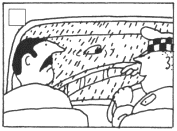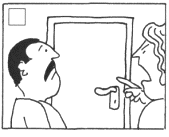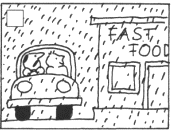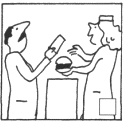Testing listening
Three people were on
a train in England. As they approached what appeared to be Wemberly Station, one
of the travelers said, "Is this Wemberly?" "No," replied a second passenger,
"it's Thursday." Whereupon the third person remarked, "Oh, I am too, let's have
a drink!"
The importance of
listening in language learning can hardly be overestimated. Through reception,
we internalize linguistic information without which we could not produce
language. In classrooms, students always do more listening than speaking.
Listening competence is universally "larger" than speaking competence. Is it any
wonder, then, that in recent years the language teaching profession has placed a
concerted emphasis on listening comprehension?
In an interactive, four-skills
curriculum, make sure that you don’t overlook the importance of techniques that
specifically develop listening comprehension competence.
Include both bottom-up and top-down
listening techniques.
Speech processing theory distinguishes
between two types of processing in both listening and reading comprehension.
Bottom-up
processing proceeds from sounds to words
to grammatical relationships to lexical meanings, etc., to a final "message."
Top-down
processing is evoked from "a bank of
prior knowledge and global expectations" and other background information that
the listener brings to the text.
Bottom-up techniques typically focus on
sounds, words, intonation, grammatical structures, and other components of
spoken language.
Top-down techniques are more concerned
with the activation of schemata, with deriving meaning, with global
understanding, and with the interpretation of a text. It is important for
learners to operate from both directions since both can offer keys to
determining the meaning of spoken discourse. However, in a communicative,
interactive context, you don't want to dwell too heavily on the bottom-up, for
to do so may hamper the development of a learner's all-important automaticity in
processing speech.
Exercise Types for Beginning-Level
Listeners
This list is taken from Teaching by
Principles; H. Douglas Brown; Prentice Hall Regents 1994)
1) Goal: Discriminating
between Intonation Contours in Sentences
Listen to a sequence of sentence
patterns with either rising or falling intonation. Place a check in column I
(rising) or column 2 (falling), depending on the pattern you hear.
2) Goal: Discriminating between
Phonemes
Listen to pairs of words. Some pairs
differ in their final consonant (stay/steak), and some pairs are the same
(laid/laid). Circle the word "same" or "different," depending on what you hear.
3) Goal: Selective Listening for
Morphological Endings
Listen to a series of sentences. Circle
"yes" if the verb has an -ed ending, and circle "no" if it does
not.
Listen to a series of sentences. On your
answer sheet are three verb forms. Circle the verb form
that is contained in the sentence
that you hear.
4) Goal: Selecting Details from
the Text (Word Recognition) Match a word that you hear with its picture.
Listen to a weather report. Look at a
list of words and circle the words that you hear. Listen to a sentence that
contains clock time. Circle the clock time that you hear, among three choices
(5:30, 5:45, 6:15).
Listen to an advertisement, select out
the price of an item, and write the amount on a price tag. Listen to a series of
recorded telephone messages from an answering machine. Fill in a chart with the
following information from each caller: name, number, time, and message.
5) Goal: Listening for
Normal Sentence Word Order
Listen to a short dialog and fill in the
missing words that have been deleted in a partial transcript.
6) Goal: Discriminating between
Emotional Reactions
Listen to a sequence of utterances.
Place a check in the column that describes the emotional reaction that you hear:
interested, happy, surprised, or unhappy.
7) Goal: Getting the Gist of a
Sentence) Listen to a sentence describing a picture and select the correct
picture.
8) Goal: Recognize the Topic
Listen to a dialog and decide where the
conversation occurred. Circle the correct location among
three multiple choice items.
Listen to a conversation and look at a
number of greeting cards that are pictured. Decide which
of the greeting cards was sent.
Write the greeting under the appropriate card.
Listen to a conversation and decide what
the people are talking about. Choose the picture that
shows the topic.
9) Goal: Build a Semantic Network
of Word Associations
Listen to a word and associate all the
related words that come to mind.
10) Goal: Recognize a Familiar
Word and Relate It to a Category
Listen to words from a shopping list and
match the words to the store that sells it.
11) Goal: Following Directions
Listen to a description of a route and
trace in on a map.
Exercise Types for
Intermediate-Level Listeners
12) Goal: Recognizing Fast Speech
Forms
Unstressed function words. Listen to a
series of sentences that contain unstressed function words. Circle your choice
among three words. Circle your choice among three words on the answer sheet—for
example: "up," "a," "of.
13) Goal: Finding the Stressed
Syllable
Listen to words of two (or three)
syllables. Mark them for word stress and predict the pronunciation of the
unstressed syllable.
14) Goal: Recognizing Words with
Reduced Syllables
Read a list of polysyllabic words and
predict which syllabic vowel will be dropped. Listen to the words read in fast
speech and confirm your prediction.
15) Goal: Recognize Words as They
Are Linked in the Speech Stream
Listen to a series of short sentences
with consonant/vowel linking between words. Mark the linkages on your answer
sheet.
16) Goal: Recognizing Pertinent
Details in the Speech Stream
Listen to a short dialog between a boss
and a secretary regarding changes in the daily schedule.
Use an appointment calendar. Cross out
appointments that are being changed and write in new ones.
Listen to announcements of airline
arrivals and departures. With a model of an airline information board in front
of you, fill in the flight numbers, destinations, gate numbers, and departure
times.
Listen to a series of short dialogs.
Before listening, read the questions that apply to the dialogs.
While listening, find the answers to
questions about prices, places, names, and numbers. Example:
"Where are the shoppers?" "How much is
whole wheat bread?"
Listen to a short telephone conversation
between a customer and a service station manager. Fill
in a chart which lists the car
repairs that must be done. Check the part of the car that needs
repair, the reason, and the
approximate cost.
17) Goal: Analyze Discourse
Structure to Suggest Effective Listening Strategies
Listen to six radio commercials with
attention to the use of music, repetition of key words, and number of speakers.
Talk about the effect these techniques have on the listeners.
18) Goal: Listen to Identify the
Speaker or the Topic
Listen to a series of radio commercials.
On your answer sheet, choose among four types of sponsors or products and
identify the picture that goes with the commercial.
19) Goal: Listen to Evaluate
Themes and Motives
Listen to as series of radio
commercials. On your answer sheet are listed four possible motives that the
companies use to appeal to their customers. Circle all the motives that you feel
each commercial promotes: escape from reality, family security, snob appeal, sex
appeal.
20) Goal: Finding Main Ideas and
Supporting Details
Listen to a short conversation between
two friends. On your answer sheet are scenes from television programs. Find and
write the name of the program and the channel. Decide which speaker watched
which program.
21) Goal: Making Inferences
Listen to a series of sentences, which
may be either statements or questions. After each sentence, answer inferential
questions, such as: "Where might the speaker be? " "How might the speaker be
feeling?" "What might the speaker be referring to?"
Listen to a series of sentences. After
each sentence, suggest a possible context for the sentence (place, situation,
time, participants).
22) Goal: Discriminating between
Registers of Speech and Tones of Voice
Listen to a series of sentences. On your
answer sheet, mark whether the sentence is polite or impolite.
23) Goal: Recognize Missing
Grammar Markers in Colloquial Speech
Listen to a series of short questions in
which the auxiliary verb and subject have been deleted. Use grammatical
knowledge to fill in the missing words: ("Have you) got some extra?" Listen to a
series of questions with reduced verb auxiliary and subject and identify the
missing verb (does it/is it) by checking the form of the main verb. Example:
'"Zit come with anything else? 'Zit arriving on time?"
24) Goal: Use Knowledge of Reduced
Forms to Clarify the Meaning of an Utterance
Listen to a short sentence containing a
reduced form. Decide what the sentence means. On your answer sheet, read three
alternatives and choose the alternative that is the best paraphrase of the
sentence you heard. Example: You hear, "You can't be happy with that." You read:
"(a) Why can't you be happy? (b) That will make you happy, (c) I don't think you
are happy".
25) Goal: Use Context to Build
Listening Expectations
Read a short want-ad describing job
qualifications in the employment section of a newspaper. Brainstorm additional
qualifications that would be important for that type of job.
26) Goal: Listen to Confirm Your
Expectations
Listen to short radio advertisements for
jobs that are available. Check the job qualifications against your expectations.
27) Goal: Use Context to Build
Expectations. Use Bottom-Up Processing to Recognize Missing Words.
Compare Your Predictions to
What You Actually Heard
Read some telephone messages with
missing words. Decide what kinds of information are missing so you know what to
listen for. Listen to the information and fill in the blanks. Finally, discuss
with the class what strategies you used for your predictions.
28) Goal: Use Incomplete Sensory
Data and Cultural Background Information to Construct a
More Complete Understanding
of a Text
Listen to one side of a telephone
conversation. Decide what the topic of the conversation might be and create a
title for it.
Listen to the beginning of a
conversation between two people and answer questions about the number of
participants, their ages, gender, and social roles. Guess the time of day,
location, tern perature, season, and topic. Choose among some statements to
guess what might come next.
Exercise Types for Advanced-Level
Learners
29) Goal: Use Features of Sentence
Stress and Volume to Identify Important Information for Note Taking
Listen to a number of sentences and
extract the content words, which are read with greater stress. Write the content
words as notes.
30) Goal: Become Aware of Sentence
Level Features in Lecture Text
Listen to a segment of a lecture while
reading a transcript of the material. Notice the incomplete sentences, pauses,
and verbal fillers.
3 I) Goal: Become Aware of
Organizational Cues in Lecture Text
Look at a lecture transcript and circle
all the cue words used to enumerate the main points. Then listen to the lecture
segment and note the organizational cues.
32) Goal: Become Aware of Lexical
and Suprasegmental Marker for Definitions
Read a list of lexical cues that signal
a definition; listen to signals of the speaker's intent such as rhetorical
questions; listen to special intonation patterns and pause patterns used with
appositives.
Listen to short lecture segments that
contain new terms and their definitions in context. Use knowledge of lexical and
intonational cues to identify the definition of the word.
33) Goal: Identify Specific
Points of Information
Read a skeleton outline of a lecture in
which the main categories are given but the specific examples are left blank.
Listen to the lecture, and find the information that belongs in the blanks.
34) Goal: Use the Introduction to the
Lecture to Predict Its Focus and Direction
Listen to the introductory section of a
lecture. Then read a number of topics on your answer sheet and choose the topic
that best expresses what the lecture will discuss.
35) Goal: Use the Lecture
Transcript to Predict the Content of the Next Section
Read a section of a lecture transcript.
Stop reading at a juncture point and predict what will come next. Then read on
to confirm your prediction.
36) Goal: Find the Main Idea of a
Lecture Segment
Listen to a section of a lecture that
describes a statistical trend. While you listen look at three graphs that show a
change over time and select the graph that best illustrates the lecture.
37) Goal: Use incoming Details to
Determine the Accuracy of Predictions about Content
Listen to the introductory sentences to
predict some of the main ideas you expect to hear in the lecture. Then listen to
the lecture as it is played. Note whether or not the instructor talks about the
points you predicted. If she/he does, note a detail about the point.
38) Goal: Determine the Main Ideas
of a Section of a Lecture by Analysis of the Details in that Section
Listen to a section of a lecture and
take notes on the important details. Then relate the details to form an
understanding of the main point of that section. Choose from a list of possible
controlling ideas.
39) Goal: Make Inferences by
Identifying Ideas on the Sentence Level That Lead to Evaluative
Statements
Listen to a statement and take notes on
the important words. Indicate what further meaning can be inferred from the
statement. Indicate the words in the original statement. Indicate the words in
the original statement that serve to cue the inference.
40) Goal: Use Knowledge of the
Text and the Lecture Content to Fill In Missing Information
Listen to a lecture segment to get the
gist. Then listen to a statement from which words have been omitted. Using your
knowledge of the text and of the general content, fill in the missing
information. Check your understand by listening to the entire segment.
41) Goal: Use Knowledge of the
Text and the Lecture Content to Discover the Lecturer's
Misstatements and to Supply the
Ideas That He Meant to Say
Listen to a lecture segment that
contains an incorrect term. Write the incorrect term and the term that the
lecturer should have used. Finally, indicate what clues helped you find the
misstatement.
Examples taken from YOU&ME
|
1) Listen to the
interviews and tick the correct answer. |
|
Brian went
to |
 |
Chicago
|
 |
Italy
|
 |
Austria
|
|
|
|
He went
with his |
 |
dad
|
 |
mother
|
 |
sister
|
 |
brother
|
|
They went
by |
 |
plane
|
 |
car
|
 |
train
|
|
|
|
They
played |
 |
badminton
|
 |
football
|
 |
golf
|
 |
table
tennis |
|
They
stayed for |
 |
one week
|
 |
two weeks
|
 |
three
weeks |
|
|
|
 |
|
Christine
went to |
 |
Chicago
|
 |
Italy
|
 |
Austria
|
|
|
|
They went
by |
 |
plane
|
 |
car
|
 |
train
|
|
|
|
She went
with her |
 |
dad
|
 |
mother
|
 |
sisters
|
 |
brothers
|
|
They
played |
 |
badminton
|
 |
with the cats and the dogs
|
 |
golf
|
|
They
stayed for |
 |
one week
|
 |
two weeks
|
 |
three
weeks |
|
|
|
|
2) Listen and take
notes. Find out the following. |
|
|
|
|
Where did
Brian go? |
Where did
Christine go? |
|
Who went
with him? |
Who went
with her? |
|
How did they get there?
|
How did they get there?
|
|
Where did
they stay? |
Where did
they stay? |
|
How long did they stay there?
|
How long did they stay there?
|
|
What did they do all day?
|
What was the weather like?
|
|
|
What did they do all day?
|
|
3) Listen to
Sylvia, Steven and Pam talking about how they get home from their school. Mark
the routes on the map and write the children's names in their houses. |
|
 |
|
4) Sandra, Jim and
Lucy are talking about mascots.
Listen and tick true or false. |
|
 |
T
|
F
|
|
Sandra has
three mascots. |
 |
 |
|
Two of her mascots are toy animals, a turtle and a mouse.
|
 |
 |
|
Sandra got the mouse from her brother James.
|
 |
 |
|
Her mother bought Sandra's necklace in Italy.
|
 |
 |
|
 |
 |
 |
|
Jim likes mascots very much.
|
 |
 |
|
He thinks mascots can help you when you have a test.
|
 |
 |
|
Lots of children in his class have mascots.
|
 |
 |
|
 |
 |
 |
|
Lucy doesn't have a mascot, but her friend Sarah has one.
|
 |
 |
|
Lucy's lucky number is thirty-two.
|
 |
 |
|
Lucy's birthday is in December.
|
 |
 |
|
|
5) Listen to the
story and put the pictures in the correct order.
Write 1 to 10 in the pictures. |
|
 |
 |
 |
|
|
|
 |
 |
 |
|
6) Listen to the
text and complete the sentences. |
|
Archibald was very unhappy because ________________
|
|
One day Archibald was able to get out of the chains because he
________________ |
|
Archibald
went back ________________ |
|
The people in the castle said, "Now the ________________
|
|
The people in the castle brought Archibald ________________
|
|
One Saturday
Archibald ________________ |
|
At midnight
Archibald ________________ |
|
After the
dance Archibald ________________
|
|
Dee put
________________ |
|
Dee
screamed,"________________ |
|
Archibald
said to Dagobert," ________________
|
|
7) First read
through the sentences below. Then listen to the story "How Melric helped a
girl at school".
Finally, put the sentences into the correct order. |
|
|
|
|
 |
The magic words were, "I can do it. I can do well in tests."
|
|
 |
She was smiling and said, "It works! It works! I can really do it!
I can do
well in tests!" |
|
 |
Melric asked her what was wrong.
|
|
 |
Melric looked at the girl and said, "I told you.
It's easy."
|
|
 |
Melric said to her, "I can help you. You must say some magic words to yourself
every night before you close your eyes."
|
|
 |
One day, Melric was in the park behind the King's garden.
|
|
 |
The girl said the magic words to herself six times every night.
|
|
 |
She said, "I'm crying because I'm so bad at school."
|
|
 |
Suddenly he saw a girl.
She was very
sad. |
|
 |
Three weeks later, Melric saw the girl in the park again.
|
|
8) Barbara, Paul
and Hannah are talking about sports.
Listen to the cassette twice and take notes on a piece of paper.
Then write down at least two sentences about each of the children. |
|
Barbara:
_____________________________________________________________ |
|
_____________________________________________________________________ |
|
Paul:_________________________________________________________________ |
|
_____________________________________________________________________ |
|
Hannah:______________________________________________________________ |
|
_____________________________________________________________________ |
|
|
9) Listen to the
story of how Melric helped a girl and write a summary. |
|
|
|
10) Listen and
find out where American children Kathleen, George, Jessica and David live.
Write the name below the correct picture. |
|
 |
|
______________ |
______________ |
______________ |
______________ |
|
|
11) Listen to
Richard, Sue and Jamie talking about pets.
Then match the sentence halves below. |
|
 |
Richard
has got |
 |
got them from his grandparents. |
|
 |
His
budgies' names |
 |
brown and black guinea pig. |
|
 |
Pit and Pat are four.
He |
 |
but Richard and his sister like it. |
|
 |
Richard's
sister's got a |
 |
are Pit
and Pat. |
|
 |
It's a lot of work to clean out the cages, |
 |
two
budgies. |
|
|
|
|
|
|
 |
Sue would like to have a dog, but she |
 |
in a house with a big garden. |
|
 |
Her parents say she can keep fish, |
 |
lives in a small flat. |
|
 |
In her dreams she lives |
 |
but she thinks they are boring. |
|
|
|
|
|
|
 |
Jamie's friend Sandra's got a little cat.
Her name |
 |
on holiday, Jamie looked after Patches. |
|
 |
The cat's eyes are green and her |
 |
is
Patches. |
|
 |
When Sandra and her parents went |
 |
fur is brown and white. |
|
|
12) Fill in
numbers to put the lines into the correct order. |
|
|
 |
and feed on tropical fruit and insects. |
 |
jungles of South and Central America |
|
 |
holes high up in the trees.
They
usually |
 |
live for about twenty years. |
|
 |
The toucan is one of the most beautiful |
 |
birds in the world. Toucans live in the |
|
 |
in groups. They build their nests in |
 |
They are very noisy and like to stay |
|
|











